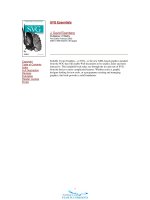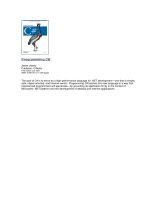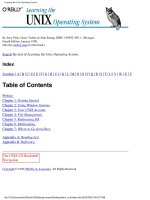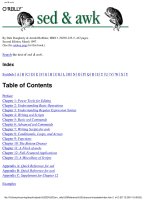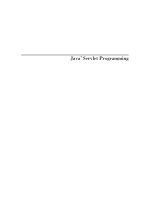o'reilly - apache cookbook
Bạn đang xem bản rút gọn của tài liệu. Xem và tải ngay bản đầy đủ của tài liệu tại đây (2.29 MB, 405 trang )
[ Team LiB ]
Table of Contents
Index
Reviews
Reader Reviews
Errata
Academic
Apache Cookbook
By Rich Bowen, Ken Coar
Publisher: O'Reilly
Pub Date: November 2003
ISBN: 0-596-00191-6
Pages: 254
The Apache Cookbook is a collection of problems, solutions, and practical examples for webmasters, web
administrators, programmers, and everyone else who works with Apache. Instead of poking around mailing lists,
online documentation, and other sources, you can rely on the Apache Cookbook for quick solutions to common
problems, and then you can spend your time and energy where it matters most.
[ Team LiB ]
[ Team LiB ]
Table of Contents
Index
Reviews
Reader Reviews
Errata
Apache Cookbook
By Rich Bowen, Ken Coar
Publisher: O'Reilly
Pub Date: November 2003
ISBN: 0-596-00191-6
Pages: 254
Copyright
Preface
What's in This Book
Platform Notes
Other Books
Other Sources
How This Book Is Organized
Conventions Used in This Book
We'd Like to Hear from You
Acknowledgments
Chapter 1. Installation
Recipe 1.1. Installing from Red Hat Linux's Packages
Recipe 1.2. Installing Apache on Windows
Recipe 1.3. Downloading the Apache Sources
Recipe 1.4. Building Apache from the Sources
Recipe 1.5. Installing with ApacheToolbox
Recipe 1.6. Starting, Stopping, and Restarting Apache
Recipe 1.7. Uninstalling Apache
Chapter 2. Adding Common Modules
Recipe 2.1. Installing a Generic Third-Party Module
Recipe 2.2. Installing mod_dav on a Unixish System
Recipe 2.3. Installing mod_dav on Windows
Recipe 2.4. Installing mod_perl on a Unixish System
Recipe 2.5. Installing mod_php on a Unixish System
Recipe 2.6. Installing mod_php on Windows
Recipe 2.7. Installing the mod_snake Python Module
Recipe 2.8. Installing mod_ssl
Chapter 3. Logging
Recipe 3.1. Getting More Details in Your Log Entries
Recipe 3.2. Getting More Detailed Errors
Recipe 3.3. Logging POST Contents
Recipe 3.4. Logging a Proxied Client's IP Address
Recipe 3.5. Logging Client MAC Addresses
Recipe 3.6. Logging Cookies
Recipe 3.7. Not Logging Image Requests from Local Pages
Recipe 3.8. Logging Requests by Day or Hour
Recipe 3.9. Rotating Logs on the First of the Month
Recipe 3.10. Logging Hostnames Instead of IP Addresses
Recipe 3.11. Maintaining Separate Logs for Each Virtual Host
Recipe 3.12. Logging Proxy Requests
Recipe 3.13. Logging Errors for Virtual Hosts to Multiple Files
Recipe 3.14. Logging Server IP Addresses
Recipe 3.15. Logging the Referring Page
Recipe 3.16. Logging the Name of the Browser Software
Recipe 3.17. Logging Arbitrary Request Header Fields
Recipe 3.18. Logging Arbitrary Response Header Fields
Recipe 3.19. Logging Activity to a MySQL Database
Recipe 3.20. Logging to syslog
Recipe 3.21. Logging User Directories
Chapter 4. Virtual Hosts
Recipe 4.1. Setting Up Name-Based Virtual Hosts
Recipe 4.2. Designating One Name-Based Virtual Host as the Default
Recipe 4.3. Setting Up Address-Based Virtual Hosts
Recipe 4.4. Creating a Default Address-Based Virtual Host
Recipe 4.5. Mixing Address-Based and Name-Based Virtual Hosts
Recipe 4.6. Mass Virtual Hosting with mod_vhost_alias
Recipe 4.7. Mass Virtual Hosting Using Rewrite Rules
Recipe 4.8. SSL and Name-Based Virtual Hosts
Recipe 4.9. Logging for Each Virtual Host
Recipe 4.10. Splitting Up a LogFile
Recipe 4.11. Port-Based Virtual Hosts
Recipe 4.12. Displaying the Same Content on Several Addresses
Chapter 5. Aliases, Redirecting, and Rewriting
Recipe 5.1. Showing Highlighted PHP Source Without Symlinking
Recipe 5.2. Mapping a URL to a Directory
Recipe 5.3. Creating a New URL for Existing Content
Recipe 5.4. Giving Users Their Own URL
Recipe 5.5. Aliasing Several URLs with a Single Directive
Recipe 5.6. Mapping Several URLs to the Same CGI Directory
Recipe 5.7. Creating a CGI Directory for Each User
Recipe 5.8. Redirecting to Another Location
Recipe 5.9. Redirecting Several URLs to the Same Destination
Recipe 5.10. Permitting Case-Insensitive URLs
Recipe 5.11. Replacing Text in Requested URLs
Recipe 5.12. Rewriting Path Information to CGI Arguments
Recipe 5.13. Denying Access to Unreferred Requests
Recipe 5.14. Rewriting Based on the Query String
Recipe 5.15. Redirecting All—or Part—of Your Server to SSL
Recipe 5.16. Turning Directories into Hostnames
Recipe 5.17. Redirecting All Requests to a Single Host
Recipe 5.18. Turning Document Names into Arguments
Chapter 6. Security
Recipe 6.1. Using System Account Information for Web Authentication
Recipe 6.2. Setting Up Single-Use Passwords
Recipe 6.3. Expiring Passwords
Recipe 6.4. Limiting Upload Size
Recipe 6.5. Restricting Images from Being Used Off-Site
Recipe 6.6. Requiring Both Weak and Strong Authentication
Recipe 6.7. Managing .htpasswd Files
Recipe 6.8. Making Password Files for Digest Authentication
Recipe 6.9. Relaxing Security in a Subdirectory
Recipe 6.10. Lifting Restrictions Selectively
Recipe 6.11. Authorizing Using File Ownership
Recipe 6.12. Storing User Credentials in a MySQL Database
Recipe 6.13. Accessing the Authenticated Username
Recipe 6.14. Obtaining the Password Used to Authenticate
Recipe 6.15. Preventing Brute-Force Password Attacks
Recipe 6.16. Using Digest Versus Basic Authentication
Recipe 6.17. Accessing Credentials Embedded in URLs
Recipe 6.18. Securing WebDAV
Recipe 6.19. Enabling WebDAV Without Making Files Writable by the Web User
Recipe 6.20. Restricting Proxy Access to Certain URLs
Recipe 6.21. Protecting Files with a Wrapper
Recipe 6.22. Protecting All Files Except a Subset
Recipe 6.23. Protecting Server Files from Malicious Scripts
Recipe 6.24. Setting Correct File Permissions
Recipe 6.25. Running a Minimal Module Set
Recipe 6.26. Restricting Access to Files Outside Your Web Root
Recipe 6.27. Limiting Methods by User
Recipe 6.28. Restricting Range Requests
Chapter 7. SSL
Recipe 7.1. Installing SSL
Recipe 7.2. Generating SSL Certificates
Recipe 7.3. Generating a Trusted CA
Recipe 7.4. Serving a Portion of Your Site via SSL
Recipe 7.5. Authenticating with Client Certificates
Chapter 8. Dynamic Content
Recipe 8.1. Enabling a CGI Directory
Recipe 8.2. Enabling CGI Scripts in Non-ScriptAliased Directories
Recipe 8.3. Using Windows File Extensionsto Launch CGI Programs
Recipe 8.4. Using Extensions to Identify CGI Scripts
Recipe 8.5. Testing That CGI Is Set Up Correctly
Recipe 8.6. Reading Form Parameters
Recipe 8.7. Invoking a CGI Program for Certain Content Types
Recipe 8.8. Getting SSIs to Work
Recipe 8.9. Displaying Last Modified Date
Recipe 8.10. Including a Standard Header
Recipe 8.11. Including the Output of a CGI Program
Recipe 8.12. Running CGI Scripts as a Different User with suexec
Recipe 8.13. Installing a mod_perl Handler from CPAN
Recipe 8.14. Writing a mod_perl Handler
Recipe 8.15. Enabling PHP Script Handling
Recipe 8.16. Verifying PHP Installation
Chapter 9. Error Handling
Recipe 9.1. Handling a Missing Host Field
Recipe 9.2. Changing the Response Status for CGI Scripts
Recipe 9.3. Customized Error Messages
Recipe 9.4. Providing Error Documents in Multiple Languages
Recipe 9.5. Redirecting Invalid URLs to Some Other Page
Recipe 9.6. Making Internet Explorer Display Your Error Page
Recipe 9.7. Notification on Error Conditions
Chapter 10. Proxies
Recipe 10.1. Securing Your Proxy Server
Recipe 10.2. Preventing Your Proxy Server from Being Used as an Open Mail Relay
Recipe 10.3. Forwarding Requests to Another Server
Recipe 10.4. Blocking Proxied Requests to Certain Places
Recipe 10.5. Proxying mod_perl Content to Another Server
Recipe 10.6. Configuring a Caching Proxy Server
Recipe 10.7. Filtering Proxied Content
Recipe 10.8. Requiring Authentication for a Proxied Server
Chapter 11. Performance
Recipe 11.1. Determining How Much Memory You Need
Recipe 11.2. Benchmarking Apache with ab
Recipe 11.3. Tuning Keepalive Settings
Recipe 11.4. Getting a Snapshot of Your Site's Activity
Recipe 11.5. Avoiding DNS Lookups
Recipe 11.6. Optimizing Symbolic Links
Recipe 11.7. Minimizing the Performance Impact of .htaccess Files
Recipe 11.8. Disabling Content Negotiation
Recipe 11.9. Optimizing Process Creation
Recipe 11.10. Tuning Thread Creation
Recipe 11.11. Caching Frequently Viewed Files
Recipe 11.12. Sharing Load Between Servers Using mod_proxy
Recipe 11.13. Distributing Load Evenly Between Several Servers
Recipe 11.14. Caching Directory Listings
Recipe 11.15. Speeding Up Perl CGI Programs with mod_perl
Chapter 12. Miscellaneous Topics
Recipe 12.1. Placing Directives Properly
Recipe 12.2. Renaming .htaccess Files
Recipe 12.3. Generating Directory/Folder Listings
Recipe 12.4. Solving the "Trailing Slash" Problem
Recipe 12.5. Setting the Content-Type According to Browser Capability
Recipe 12.6. Handling Missing Host: Header Fields
Recipe 12.7. Alternate Default Document
Recipe 12.8. Setting Up a Default "Favicon"
Appendix A. Using Regular Expressions in Apache
Section A.1. What Directives Use Regular Expressions?
Appendix B. Troubleshooting
Section B.1. Troubleshooting Methodology
Section B.2. Debugging the Configuration
Section B.3. Debugging Premature End of Script Headers
Section B.4. Common Problems on Windows
Section B.5. Fixing Build-Time Error Messages
Section B.6. Getting Server-Side Includes to Work
Section B.7. Debugging Rewrites That Result in "Not Found" Errors
Section B.8. .htaccess Files Having No Effect
Section B.9. Address Already in Use
Colophon
Index
[ Team LiB ]
[ Team LiB ]
Copyright
Copyright 2004 Ken Coar and Rich Bowen.
Printed in the United States of America.
Published by O'Reilly & Associates, Inc., 1005 Gravenstein Highway North, Sebastopol, CA 95472.
O'Reilly & Associates books may be purchased for educational, business, or sales promotional use. Online editions
are also available for most titles (). For more information, contact our corporate/institutional
sales department: (800) 998-9938 or
Nutshell Handbook, the Nutshell Handbook logo, and the O'Reilly logo are registered trademarks of O'Reilly &
Associates, Inc. Many of the designations used by manufacturers and sellers to distinguish their products are claimed
as trademarks. Where those designations appear in this book, and O'Reilly & Associates, Inc. was aware of a
trademark claim, the designations have been printed in caps or initial caps. The association between the image of a
moose and the topic of Apache is a trademark of O'Reilly & Associates, Inc.
While every precaution has been taken in the preparation of this book, the publisher and authors assume no
responsibility for errors or omissions, or for damages resulting from the use of the information contained herein.
[ Team LiB ]
[ Team LiB ]
Preface
The Apache web server is a remarkable piece of software. The basic package distributed by the Apache Software
Foundation is quite complete and very powerful, and a lot of effort has gone into keeping it from suffering software
bloat. One facet of the package makes it especially remarkable: it includes extensibility by design. In short, if the
Apache package right out of the box does not do what you want, you can generally extend it so that it does. Dozens
of extensions (called modules) are included as part of the package distributed by the Apache Software Foundation.
And if one of these doesn't meet your needs, with several million users out there, there is an excellent chance
someone else has already done your work for you, who has concocted a recipe of changes or enhancements to the
server that will satisfy your requirements.
This book is a collection of these recipes. Its sources include tips from the firehose of the USENET newsgroups, the
Apache FAQ, Apache-related mailing lists, mail containing "how-to" questions, questions and problems posed on
IRC chat channels, and volunteered submissions.
All of the items in this book come from real-life situations, encountered either by us or by other people who have
asked for our help. The topics range from basic compilation of the source code to complex problems involving the
treatment of URLs that require SSL encryption.
We've collected more than a hundred different problems and their solutions, largely based on how often they
occurred, and have grouped them roughly by subject as shown in What's in This Book.
Primarily, these recipes are useful to webmasters who are responsible for the entire server; however, many are
equally applicable to users who want to customize the behavior in their own web directories through the use of
.htaccess files.
We've written Apache Cookbook to be a practical reference, rather than a theoretical discourse: reading it recipe by
recipe, chapter by chapter, isn't going to reveal a plot ("Roy Fielding in the Library with an RFC!"[1]). It's intended
to provide point solutions to specific problems, located through the table of contents or the index.
[1] An obscure reference to a board game called Clue and an obscure developer of HTTP.
[ Team LiB ]
[ Team LiB ]
What's in This Book
Because much of the material in this book is drawn from question-and-answer discussions and consultations, we
have tried to make it as complete as possible. Of course, this means that we have included "recipes" for some
questions to which there are currently no satisfactory answers (or at least to our knowledge). This has not been done
to tease, annoy, or frustrate you; such recipes are included to provide completeness, so that you will know those
problems have been considered rather than ignored.
Very few problems remain insoluble forever, and these incomplete recipes are the ones that will receive immediate
attention on the book's web site and in revisions of the book. If a reader has figured out a way to do something the
book mentions but doesn't explain, or omits mentioning entirely, our research team can be notified, and that solution
will go on the web site and in the next revision.
Who knows, you may be the one to provide such a solution!
[ Team LiB ]
[ Team LiB ]
Platform Notes
The recipes in this book are geared toward two major platforms: Unixish ones (such as Linux, FreeBSD, and
Solaris) and Windows. There are many that have no platform-specific aspects, and for those any mention of the
underlying operating system or hardware is gratefully omitted. Due to the authors' personal preferences and
experiences, Unixish coverage is more complete than that for the Windows platforms. However, contributions,
suggestions, and corrections for Windows-specific recipes will be gladly considered for future revisions and inclusion
on the web site.
[ Team LiB ]
[ Team LiB ]
Other Books
There are a number of books currently in print that deal with the Apache web server and its operation. Among them
are:
•
Apache: The Definitive Guide, Third Edition (O'Reilly)
•
Apache Unleashed (Macmillan)
•
Apache Administrator's Handbook (Macmillan)
You can also keep an eye on a couple of web pages that track Apache titles:
•
/>•
/>
[ Team LiB ]
[ Team LiB ]
Other Sources
In addition to books, there is a wealth of information available online. There are web sites, mailing lists, and USENET
newsgroups devoted to the use and management of the Apache web server. The web sites are limitless, but here are
some active and useful sources of information.
•
The comp.infosystems.www.servers.unix and comp.infosystems.www.servers.ms-dos USENET
newsgroups. Although these aren't dedicated to Apache specifically, there is a lot of traffic concerning it, and
experienced Apache users hang out here. If you don't have access to news, or know how to reach
USENET, check out />•
The Apache Today web site, run by Internet.Com. This site regularly lists articles about the web server and
making the most of it. The URL is />•
The mailing list is populated with people who have varying degrees of experience
with the Apache software, and some of the Apache developers can be found there, too. Posting is only
permitted to subscribed participants. To join the list, visit />•
The #apache IRC channel on the irc.freenode.net network—or on many other IRC networks, for that
matter. However, your chances of encountering us are most likely on the freenode network.
We must point out that none of these is an "official" support medium for the web server. In fact, there is no "official"
support path, since the software is largely developed by volunteers and is free. However, these informal support
forums successfully answer many questions.
[ Team LiB ]
[ Team LiB ]
How This Book Is Organized
This book is broken up into twelve chapters and two appendixes, as follows:
Chapter 1 covers the basics of installing the vanilla Apache software, from source on Unixish systems, and on
Windows from the Microsoft Software Installer (MSI) package built by the Apache developers.
Chapter 2 describes the details of installing some of the most common third-party modules, and includes generic
instructions that apply to many others that have less complex installation needs.
Chapter 3 includes recipes about recording the visits to your web site(s), and Apache's error logging mechanism.
Chapter 4 tells you how to run multiple web sites using a single Apache server and set of configuration files.
Chapter 5 describes how to manipulate URLs, how to control which files they refer to, how to change them from one
thing to another, and how to make them point to other web sites.
Chapter 6 covers some of the basic issues of securing your Apache server against penetration and exposure by the
nefarious elements on the Internet.
Chapter 7 addresses the issues of making your Apache web server capable of handling secure transactions with
SSL-capable browsers—a must if you're going to be handling sensitive data such as money transfers or medical
records.
Chapter 8 tells you how to enhance your server with runtime scripts and make them operate as a particular user.
Chapter 9 describes how to customize the web server's error messages to give your site its own unique flavor.
Chapter 10 describes how to configure your Apache server to act as a proxy between users and web pages and
make the processes as transparent and seamless as possible.
Chapter 11 includes a number of recipes for addressing performance bottlenecks and improving the overall function
of your Apache server.
Chapter 12 covers a variety of miscellaneous topics that didn't seem to fit into any of the other chapters.
Appendix A explains how regular expressions are used for pattern-matching in Apache directives.
Appendix B covers some basic troubleshooting techniques, where to look for messages, common configuration
problems, etc.
[ Team LiB ]
[ Team LiB ]
Conventions Used in This Book
Throughout this book certain stylistic conventions are followed. Once you are accustomed to them, you can easily
distinguish between comments, commands you need to type, values you need to supply, and so forth.
In some cases, the typeface of terms in the main text will be different and likewise in code examples. The details of
what the different styles (italic, boldface, etc.) mean are described in the following sections.
Programming Conventions
In this book, most case examples of code will be in the form of excerpts from scripts, rather than actual application
code. When commands need to be issued at a command-line prompt (such as an xterm for a Unixish system or a
DOS command prompt for Windows), they will look something like this:
% find /usr/local -name apachectl -print
# /usr/local/apache/bin/apachectl graceful
C:>cd "\Program Files\Apache Group\Apache\bin"
C:\Program Files\Apache Group\Apache\bin>apache -k stop
On Unixish systems, command prompts that begin with # indicate that you need to be logged in as the superuser
(root username); if the prompt begins with %, then the command can be used by any user.
Typesetting Conventions
The following typographic conventions are used in this book:
Italic
Used for commands, filenames, abbreviations, citations of books and articles, email addresses, URLs, and USENET
group names.
Bold
Used for labeling menu choices in a graphical interface.
Constant Width
Used for function names, command options, computer output, environment variable names, literal strings, and code
examples.
Constant Width Bold
Used for user input in computer dialogues and examples.
Constant Width Italic
Used for replaceable parameters, filesystem paths, and variable names.
This icon signifies a tip, suggestion, or general note.
This icon indicates a warning or caution.
Documentation Conventions
Since this book deals with a general topic rather than a specific one (such as the Perl language), there are additional
sources of information to which it will refer you. The most common ones are:
The online manual ("man") pages on a Unixish system
References to the manpages will appear something like, "For more information, see the kill(1) manpage." The number
in parentheses is the manual section; you can access this page with a command such as:
% man 1 kill
The Apache web server documentation
Such a reference may appear as "See the mod_auth documentation for details." This refers to a web page like:
In some cases, the reference will be to a specific Apache directive rather than an actual module; in cases like this, you
can locate the appropriate web page by looking up the directive name on:
This page lists all of the directives available in the standard Apache package. In some situations, the directive may be
specific to a nonstandard or third-party module, in which case the documentation should be located wherever the
module itself was found. The links above are for the documentation for Version 1.3 of the software. To access the
documentation for Version 2.0, replace "docs/" with "docs-2.0/" in the URLs.
[ Team LiB ]
[ Team LiB ]
We'd Like to Hear from You
We have tested and verified the information in this book to the best of our ability, but you may find that features have
changed (which may in fact resemble bugs). Please let us know about any errors you find, as well as your suggestions
for future editions, by writing to:
Please address comments and questions concerning this book to the publisher:
O'Reilly & Associates, Inc.1005 Gravenstein Highway NorthSebastopol, CA 95472(800) 998-9938 (in the United
States or Canada)(707) 829-0515 (international or local)(707) 829-0104 (fax)
We have a web page for this book, where we list errata, examples, and any additional information. You can access
this page at:
To comment or ask technical questions about this book, send email to:
For more information about our books, conferences, Resource Centers, and the O'Reilly Network, see our web site
at:
We have a web site for the book, where we'll list errata and plans for future editions. Here you'll also find the source
code from the book available for download so you don't have to type it all in:
[ Team LiB ]
[ Team LiB ]
Acknowledgments
Originally, each recipe was going to be individually attributed, but that turned out to be logistically impossible.
Many people have helped us during the writing of this book, by posing a problem, providing a solution, proofreading,
reviewing, editing, or just (!) providing moral support. This multitude, to each of whom we are profoundly grateful,
includes Nat Torkington (our project editor and demonstrator of Herculean feats of patience), Sharco and Guy- from
#apache on irc.freenode.net, Mads Toftum, Morbus Iff (known to the FBI under the alias Kevin Hemenway), and
Andy Holman.
Ken Coar
I dedicate this book to my father, Richard J. Coar, for all the various kinds of support he has provided over the years.
My sincere thanks go out to the crew at O'Reilly, including Paula and Nat, who apparently never gave up hope
regardless of how many deadlines whooshed past unmet. Thanks also to the WriterBase Authors Support Group and
Cabal mailing lists, whereon much balm and advice was offered. Our technical reviewers Morbus and Quasi
provided much excellent feedback and helped make this a better book. The VMware software package was very
useful, and I'm grateful to its makers for their help and support.
The people who have worked on the Apache web server documentation, and the people who develop the software
itself, get a big note of thanks, too; without the former, collating a lot of the information in this book would have been
a whole lot more difficult, and without the latter, the book wouldn't have happened at all.
The users of the software, whose frequently challenging questions populate the mailing lists, the IRC channels, and
our inboxes, deserve thanks for all the inspiration they unwittingly provided for the recipes in this book.
But foremost among those to whom I owe gratitude is my significantly better half, Cathy, without whose patience,
support, and constructive criticism I would never have achieved what I have.
Rich Bowen
I dedicate this book to Sarah, who is the motivation for all the important things I do.
While it would be impossible to adequately thank all the folks who made this book possible, there are some people,
in addition to those already mentioned, that I'd like to especially thank.
A huge thank you to our technical reviewers. You created a huge quantity of additional work for us, made our lives
miserable, and made the book late. I don't think I've ever had such a thorough tech review, and the comments that
you made served to make this a much better book than it otherwise would have been. Without quasi, large parts of
the book would have been significantly less complete—and less correct. And Morbus gave the entire project the sort
of surreal, other-worldly aura that you expect from well, from Morbus. Thank you both and to the many other
people who made various remarks about what we'd written.
To my wonderful family, thank you all. You have helped me through a very difficult time, and shown more love,
patience, and acceptance than I deserve. Mom and Dad, I love you. Ruth, you have given me the courage to plough
on. Andy, you are my hero.
Thanks to the folks on the Apache web server documentation project. The Apache documentation is some of the
best in the world of free software. Thanks to the dedication and attention to detail.
To the folks on irc.freenode.net, you are the ones who made this book happen. The recipes in this book are answers
to questions that you asked, refined over time by dozens and dozens of people who asked them again and again and
again.
And, finally, thanks to the members of the Geocachers of Central Kentucky ( for getting me
hooked on Geocaching, and placing the caches around the area, giving me something to go out and do when my
sanity was stretched a little thin.
[ Team LiB ]
[ Team LiB ]
Chapter 1. Installation
For this cookbook to be useful, you need to install the Apache web server software. So what better way to start than
with a set of recipes that deal with the installation?
There are many ways of installing this package; one of the features of open software like Apache is that anyone may
make an installation kit. This allows vendors (such as Debian, FreeBSD, Red Hat, Mandrake, Hewlett-Packard, and
so on) to customize the Apache file locations and default configuration settings so that these settings fit with the rest of
their software. Unfortunately, one of the consequences of customization is that the various prepackaged installation
kits are almost all different from one another.
In addition to installing it from a prepackaged kit, of which the variations are legion, there's always the option of
building and installing it from the source yourself. This has both advantages and disadvantages; on the one hand you
know exactly what you installed and where you put it, but on the other hand, it's likely that binary add-on packages
will expect files to be in locations different than those you have chosen.
If setting up the web server is something you're going to do once and never again, using a packaged solution
prepared by your system vendor is probably the way to go. However, if you anticipate applying source patches,
adding or removing modules, or just fiddling with the server in general, building it yourself from the ground up is
probably the preferred method. (The authors of this book, being confirmed bit-twiddlers, always build from source.)
This chapter covers some of the more common prepackaged installation varieties and also how to build them from
the source yourself.
Throughout the chapter, we assume that you will be using dynamic shared objects (DSOs) rather than building
modules statically into the server. The DSO approach is highly recommended; it not only makes it easy to update
individual modules without having to rebuild the entire server, but it also makes adding or removing modules from the
server's configuration a simple matter of editing the configuration file.
DSOs on Unixish systems typically have a .so extension; on Windows they end with a .dll suffix.
[ Team LiB ]
[ Team LiB ]
Recipe 1.1 Installing from Red Hat Linux's Packages
Problem
You have a Red Hat Linux server and want to install or upgrade the Apache web server on it using the packages that
Red Hat prepares and maintains.
Solution
If you are a member of the Red Hat Network (RHN), Red Hat's subscription service, you can use Red Hat's
up2date tool to maintain your Apache package:
# up2date -ui apache apache-devel apache-manual
If you're running a more recent version:
# up2date -ui httpd httpd-devel httpd-manual
If you aren't a member of RHN, you can still download the packages from one of Red Hat's servers (either
or and install it with the following command:
# rpm -Uvh apache
Discussion
The -Uvh option to the rpm command tells it to:
•
Upgrade any existing version of the package already on the system or install it for the first time if it isn't.
•
Explain the process, so you can receive positive feedback that the installation is proceeding smoothly.
•
Display a pretty line of octothorpes (#) across the screen, marking the progress of the installation.
If you use the packages Red Hat maintains for its own platform, you will benefit from a simple and relatively standard
installation. However, you can only update versions that Red Hat has put together an RPM package for, which
typically means that you may be lagging weeks to months behind the latest stable version.
There is also the issue of platform compatibility; for instance, at some point the version of Apache provided for Red
Hat Linux changed from 1.3 to 2.0, and newer versions of the operating system will probably only have the 2.0
packages available. Similarly, if you run an older version of Red Hat Linux, the newer packages will probably not
install properly on your system.
It's a good idea to install the apache-devel package as well. It's quite small, so it won't have much impact on your
disk usage; however, it includes files and features that a lot of third-party modules will need to install properly.
See Also
•
Red Hat's full platform release archive at />•
Red Hat's incremental update (errata) archive at />
